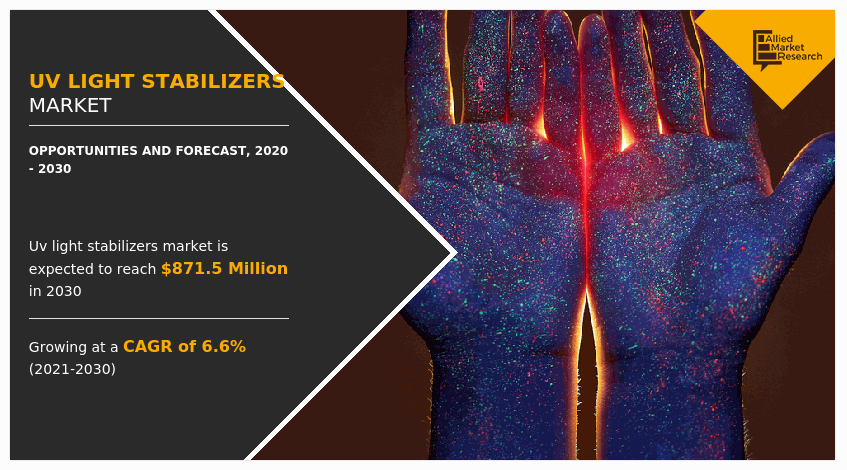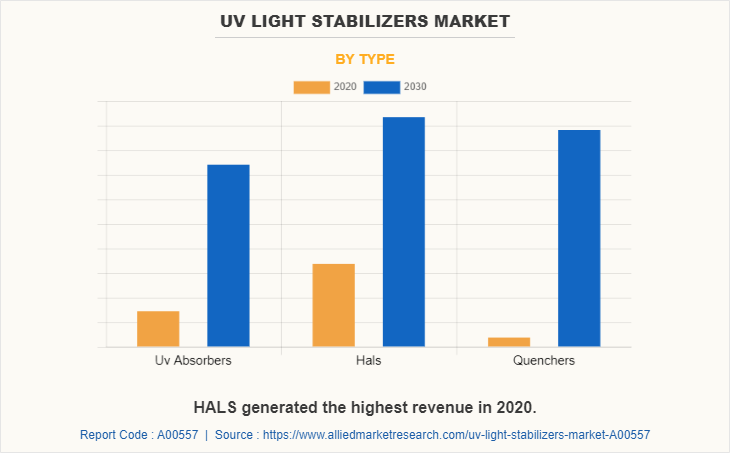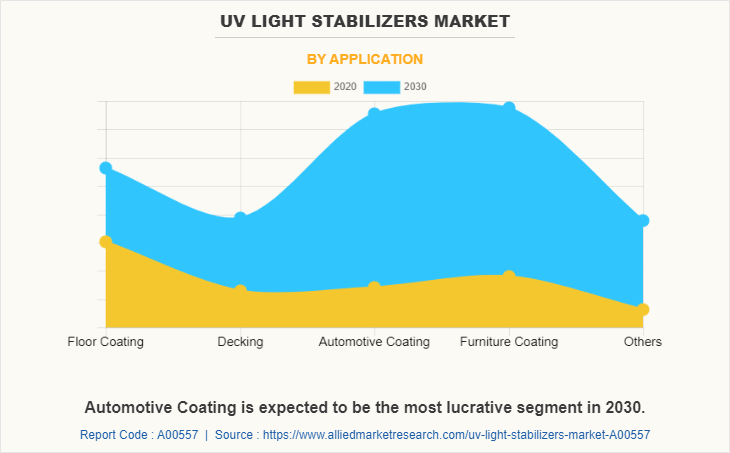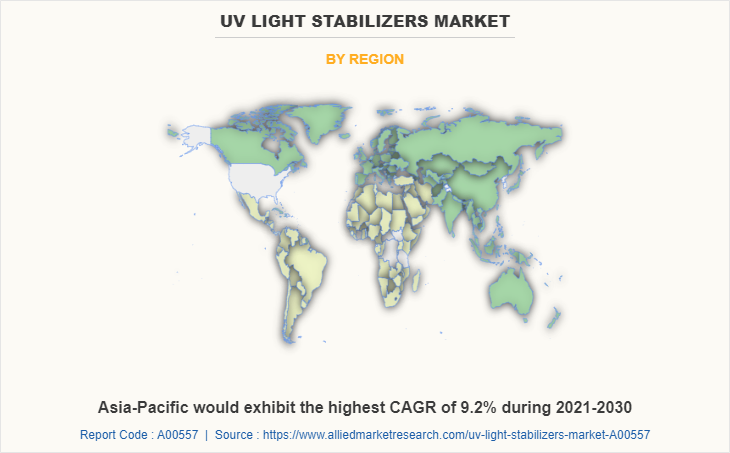UV Light Stabilizers Market Research, 2030
The global UV light stabilizers market size was valued at $462.9 million in 2020 and is projected to reach $871.5 million by 2030, registering a CAGR of 6.6% from 2021 to 2030.
UV light stabilizers protect plastic or wooden components from the long-term effects of UV radiation. A polymer photo-degradation process occurs when a substance is exposed to UV radiation, resulting in deterioration of physical properties of the substance such as changes in color, loss of strength, elongation & tensile strength properties, or chalking of the surface. For instance, plastic or wooden chairs kept in gardens become brittle and lose their glossiness, and chairs kept in open stadiums appear to be chalky or sometimes crack into pieces. Therefore, manufacturers use UV light stabilizers to protect components that are exposed to UV radiation to prevent damage & losses.

UV absorbers, hindered amine light stabilizers (HALS), and quenchers are the key types of UV light stabilizers. Among these, HALS occupies more than 70% of the global UV stabilizer market share, followed by UV absorbers, constituting around 23%. UV absorbers are cost-effective, which is expected to boost the demand for UV light stabilizers forecast.

The surge in demand for wood and plastic coatings for protection against UV radiation drives the growth of the UV light stabilizer market share. In addition, the increase in the use of wood and plastics for decking applications has triggered the demand for UV light protection coatings, which, in turn, fosters the growth of the UV light stabilizers market growth. The ongoing development of the housing and construction industries in Asia-Pacific is expected to notably contribute toward the UV light stabilizers market analysis. In addition, the use of nanotechnology in the coating industries supplements the UV light stabilizers market growth.
The value chain UV light stabilizers industry includes various stakeholders such as manufacturers of components, semiconductor manufacturers, original equipment manufacturers, and service providers. Each of these players shares a specific value at their point of operation, which, in turn, contributes toward the competitive value of the product. R&D activities, innovations, marketing strategies, and aesthetic concerns enhance the overall value associated with end deliverables by each of the market players.

Segmentation Overview:
The global UV light stabilizers market share is segmented into type, application, and region. By type, the market is fragmented into UV absorbers, HALS, and quenchers. Based on application, it is categorized into floor coating, decking, automotive coating, furniture coating, and others. Region-wise, the market is analyzed across North America, Europe, Asia-Pacific, and LAMEA.

The key players mentioned in the UV light stabilizers industry are Altana AG, BASF AG, Akzo Nobel, Solvay, Lanxess, Clariant Ltd., Everlight Chemical Industrial, Mayzo, Valtris Speciality, and Lycus Ltd. These key players have adopted strategies, such as product portfolio expansion, mergers & acquisitions, agreements, geographical expansion, and collaborations to enhance their market penetration.
Top Impacting Factors
The notable factors affecting the UV light stabilizers industry include an increase in the level of UV radiation due to ozone depletion that affects different materials such as plastics and wood. The growth of the UV light stabilizers market is fueled by the boom in the construction industry and the increase in the usability of plastic and wooden materials in the construction industry for applications such as floor coating, decking, and fencing. Plastic is a cheaper substitute for traditional construction materials, hence, the adoption of plastic materials is widely witnessed in the construction sector. However, the cost of UV stabilizers is high, which limits the market growth.
Increase in Level of UV Radiations
Synthetic polymers such as plastics as well as naturally occurring polymer materials such as wood are extensively used in building construction and other outdoor applications where they are routinely exposed to sunlight. The UV-B content in sunlight is known for adversely affecting the mechanical properties of these materials, casting doubt over their usability. Any increase in the solar UV-B content owing to a partial ozone depletion would therefore tend to decrease the outdoor service life of these materials.
High Cost:
The cost of adding UV stabilizers would eventually lead to a price hike for the product. Customers incur the extra burden of cost. HALS are the most common type of stabilizers, which are used in many applications such as flooring, decking, and automotive. The maximum adoption of HALS is attributed to its early adoption as a UV stabilizer and comparatively high shelf life compared to other UV stabilizers. However, the cost of HALS is high, thereby limiting the UV light stabilizers industry. UV absorbers are more affordable than HALS. However, the limited shelf life of UV absorbers minimizes their application.
Product Advancements and Increase in Disposable Income
Conventional UV absorbers are organic molecules with various chemical structures. They are incapable of exhibiting long-term stability in coatings. Inorganic compounds such as titanium dioxide, ceria, and zinc oxide absorb radiations in the UV region and they have the additional advantage of greater long-term protection. Their disadvantage is that because they are solid particles they can reduce the transparency of the coating film. This effect can be minimized by reducing their particle size to nanometers, the smaller the particle size, the greater the transparency.
Key Benefits For Stakeholders
- This report provides a quantitative analysis of the market segments, current trends, estimations, and dynamics of the uv light stabilizers market analysis from 2020 to 2030 to identify the prevailing uv light stabilizers market opportunities.
- The market research is offered along with information related to key drivers, restraints, and opportunities.
- Porter's five forces analysis highlights the potency of buyers and suppliers to enable stakeholders to make profit-oriented business decisions and strengthen their supplier-buyer network.
- An in-depth analysis of the UV light stabilizers market segmentation assists in determining the prevailing market opportunities.
- Major countries in each region are mapped according to their revenue contribution to the global market.
- Market player positioning facilitates benchmarking and provides a clear understanding of the present position of the market players.
- The report includes an analysis of the regional as well as global UV light stabilizers market trends, key players, market segments, application areas, and market growth strategies.
UV Light Stabilizers Market Report Highlights
| Aspects | Details |
| By Type |
|
| By Application |
|
| By Region |
|
| Key Market Players | LYCUS, Akzo Nobel N.V., Lanxess, clariant, Mayzo, everlights, solvay, altana ag, BASF, valtris specialty chemicals |
Analyst Review
The UV-B radiations of sunlight adversely affect the mechanical properties of materials such as plastics and wood, thereby limiting their shelf life. There are three types of stabilizers available in the market, which include hindered amine light stabilizers (HALS), UV absorbers, and quenchers. HALS occupies a dominant market share, owing to its usability in many applications and long shelf life as compared to other UV stabilizers. UV stabilizers are commonly seen in coating applications such as flooring, decking, furniture, and automobiles. Flooring and decking applications significantly contribute to the revenue generation of the overall UV light stabilizer market.
The booming construction industry leads to rising demand for construction materials. The exposure of roofing tiles & shakes, solar shingles, shutters, and roofing membrane to UV light causes cracking, crazing, chalking, color changes, and loss of strength in them. Hence, these components require effective UV and heat stabilization loading to resist the abovementioned harmful UV effects. Asia-Pacific accounted for more than 50% of the market share, owing to large industrial base of construction, automotive, and packaging industries.
Several companies operating in UV light stabilizer market have adopted product launch, agreements, and partnerships as their key strategies to gain a prominent foothold in the market. The market would be influenced by the increasing awareness of the harmful effects of UV radiation. Many companies prefer a combination of UV absorbers and HALS for protection against UV radiations.
The growth of UV light stabilizers market is fueled with the boom in construction industry and increase in usability of plastic and wooden materials in the construction industry for applications such as floor coating, decking, and fencing
HALS is projected to be one of the leading application of UV light stabilizers market
North America is projected to be the largest regional market for UV light stabilizers market
The global UV light stabilizers market size was valued at $462.9 million in 2020, and is projected to reach $871.5 million by 2030, registering a CAGR of 6.6% from 2021 to 2030.
The key players such as Altana AG, BASF AG, Akzo Nobel, Solvay, Lanxess, and Clariant Ltd among others holds significant share in the UV light stabilizers market
Loading Table Of Content...



